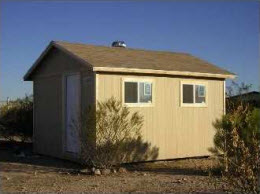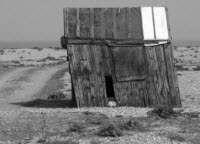Buying a Wooden Storage Shed - What Are The Main Points To Look For?
Imagine you are not buying a wooden storage shed, you are buying a car.
You know the capacity of the engine.
The number of brake horsepower it produces at 2,000 revs.
How long it takes to go from 0-60mph.
How wide it is. It will it fit in the garage, won't it?
You have spent hours reading the motoring magazines comparing it to other cars in the same price bracket.
How much it is new. How quickly it will depreciate.... etc etc
Yes, I know there isn't the same level of excitement in choosing a new wooden storage shed as choosing a new car. However the same sorts of principles apply, you need to look at the product specification to be sure that you really will be happy with your new purchase.
What are the important things that I need to look for in a wooden storage shed?

Before we start you need to realise that like cars all wooden storage sheds are not created equal. If you want a top end shed, such as a garden office, that you will be comfortable working in all day, all year round then it will be a completely different specification to a wooden garden shed that we are talking about in this article.
In this article I am talking about the specification for a relatively cheap wooden shed for the purpose of storing your garden tools, mower, deck chairs and other commonly used garden implements. In car terms this is the equivalent of the family run around. You want it to do its job, not be too expensive and you definitely do not want to be repairing it all the time. It should also last forever.
The first thing to consider is the frame work of the shed
What size timbers are used and what spacing are they. For a reasonable quality wooden storage shed you should make sure that for the wall timbers that what you are getting is at least 2" x 1 ½" (50x38mm) and at a maximum of 2' (600mm) centres.
When making a shed the manufacturer will be fabricating the shed to a price point. If he wants to make a shed that costs £200 and have a certain profit margin then he will just reduce the amount of timber in the shed until that figure is reached.
If you look at some wooden sheds you will see that this figure is reduced considerably. The problem with this is that the strength of the timber reduced by making it smaller. But more importantly if there are any imperfections in the wood, such as knot or shakes, then the timber could be rendered useless.
The timbers also need to be a certain size so that the timber cladding can be fixed securely to it.
What are the different types of timber cladding
Timber cladding comes in three broad categories. Weather board, ship lap and tongue and groove. The picture shows how each of these look.
Weather board is the cheapest option as it is just rough sawn timber and does not interlock at all. If (when) the timber distorts then the air gaps will open up and although the shed may remain waterproof it will not really be weather tight.
Ship lap timber is a bit more machined than weather board and consequently slightly more weather tight.
Tongue and groove cladding is the best option and because adjoining boards interlock the really is a solid wall of timber.
All of these different boards come in a range of thicknesses
What thickness of board should I look for? I have seen some wooden storage sheds on the internet that have a wall thickness of 9mm. This really is very thin. When board are this thin they tend to be more susceptible to changes in moisture content and they warp more readily. They are also weaker and so when they get hit by a football or base ball they are more easily damaged. 9mm really is very thin.
I would say that the walls of the shed should be at least ¾" (16mm) thick. By making the walls almost twice as thick the durability of the shed is increased. It will also be more secure as the nails are fixed into a greater depth of material.
Just by looking at the volume of timber needed to build a wooden storage shed you can see that the major saving to the manufacturer is on the cladding. By offering a lot thinner cladding material costs have been almost halved.
But just having the right amount of timber in the shed is not going to make a strong shed
 Timber shed that did not have
Timber shed that did not have
sufficient bracing in the walls
Details such as bracing will also influence the robustness of the frame. Braces are the diagonal members in the shed wall. The braces resist the wind loads on the shed and stop it 'racking'.
Good quality manufacturers always include bracing in some form. Others don't, my opinion is that lack of bracing is the main cause of failure for structures of any size. If your shed does not have any, install some today!
The roof and floor also consume a good amount of material.
What should a wooden storage shed roof and floor be made from?
Traditionally shed roofs and floors were made out of solid timber. But more recently they are made out of OSB (Oriented Strand Board). Good quality OSB is water resistant and it will not lose its strength if it gets wet. However like most timber it should be kept as dry as possible. The thicknesses used in the roof could be as thin as ½" (12mm) but for the floor ¾" (18mm) is a good thickness to aim for.
Having talked about the main structure what about details such as the doors and windows.
What about the doors?
The door to a wooden garden shed will most likely be of the ledged and braced type. The thickness of the boards to the door will be similar to the main cladding. As with the structure some manufacturers leave out the bracing on the door. This is short sighted as the door will quickly sag.
The main upgrade here would be to have a fully framed door. This would be much more secure.
The windows
Most windows will be either fixed or simply opening. The standard glass that is used is 3mm horticultural glass. This is quite fragile and if hit by a football will shatter into quite large shards. Safety glass is an upgraded option.
Summary
The main components of a wooden storage shed that you need to pay attention to are:
- The structural timbers
- The cladding
- Details such as bracing
- The floor and roof
- Doors and windows
Your specification for timber shed buying success
If you follow the recommendations in this article you should be able to tell the difference between a good quality shed and a shoddy shed.
We all know what types of car will go from 0-60 mph in the shortest time possible. I hope that this article will help you choose a wooden garden shed that will go from 0-60 years with as few problems as possible and spend as little time as possible in the garage.

Keep in touch with our monthly newsletter
Shed Building Monthly




